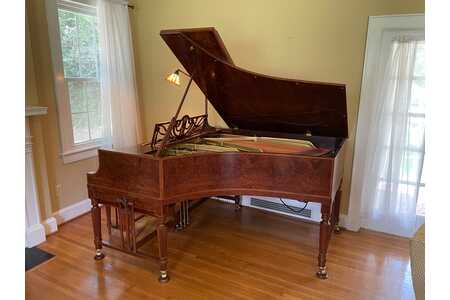

Description of piano and its present condition, based on your assessment on July 15, 2022:
Type of Piano: Baby Grand / Grand Brand Name of Piano: Knabe Model: 437B
Serial Number: 68150 Approximate Age: 112
Size Length: 6’4
All Notes Work Properly: Yes
Automatic-Player Piano: Yes - Electric "Reproducer" with Expression Rolls / AMPICO
Wood Finish: Polish: Satin - Shiny, but not mirror like
Wood Finish: Color: Medium Brown
Cabinet Style: Slightly Ornate
Wood or Veneer: Burled Walnut
Rebuilt & Reconditioned: Refinished Cabinet, New Strings, New Hammers, New Pinblock, Plate Refinished, Soundboard / Bridges repaired, Action - Reconditioned / Renewed Original Parts, Action - Restored or Replaced with New Parts / Don Valley
Present Condition: Reconditioned - has received extensive repair/replacement /upgrading of parts
Principal Storage Location: Inner wall, Near Window(s)
Service History: please request additional photos and service history.
Piano Bench: original and matching as seen in photos
Player rolls: Approximately 80
TYPE OF PIANO:
Knabe 6’4” Grand with AMPICO Player (Antique)
DATE OF MANUFACTURE ACCORDING TO SERIAL NUMBER:
1910
AGE OF PIANO AS OF 2022:
112 years (Antique as of 2010) \
MANUFACTURER:
W.M. Knabe Pianos was founded by William Knabe who learned his craft as a cabinet and piano maker in Germany, the country where he was born, in the city of Kreuzberg. He moved to Baltimore, Maryland in 1833 and worked for a piano builder. He started his own business in 1835 buying and selling, tuning and repairing used pianos. In 1837, Mr. Knabe partnered with another piano builder, William Henry Gaehle to form Knabe &
PAGE 1 of 3
Gaehle. In 1955, Gaehle passed away. Knabe gained control of the company and changed the name to William Knabe & Co. The company was left to his two sons, Earnest and William Knabe Jr. when WIlliam had died in 1864. Throughout the 1800s and early 1900s, Knabe became one of the most respected names in piano history, building high quality square grand (until the late 1800s), upright, and grand pianos. His numerous patents and innovations helped to improve and to develop the piano’s modern design. In 1908 the company incorporated and joined the American Piano Co. In 1926, Knabe was chosen to be the official piano of the New York Metropolitan Opera. By 1932, the Aeolian Corp. of New York merged with the American Piano Co., and with it, the Knabe name. The factory was then located in East Rochester, New York. By the mid 1980s, after Aeolian went out of business, the Mason & Hamlin Corp. then owned this name until they stopped production in 1994. In the 1990s Korean company, Young Chang, began manufacturing Knabe pianos for Mason & Hamlin. The name was then sold to Korean firm, Samick (SMC), who now produce premium-level pianos bearing the Knabe name, using the original Knabe scales and designs within their higher-end piano models.
The key to your piano's value is its perceived value as a rare and scarce antique (as of 2010).
Other keys to the piano’s value are its AMPICO player, burled walnut finish, and ornate cabin


 *SOLD* Extremely Rare and Fabulous Knabe Ampico Reproducer
*SOLD* Extremely Rare and Fabulous Knabe Ampico Reproducer 





 Similar Pianos
Similar Pianos Resources View More >
Resources View More >